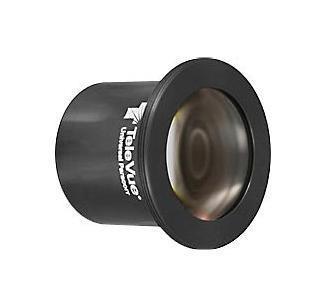
3 minute read
Field Flatteners, Focal Reducers and Coma Correctors
One accessory that has become almost de rigueur in imaging these days is the field flattener. Almost all telescope designs have some curvature of field which means that the focal plane is not a flat surface but is a section of a curve. Some types show more curvature than others but very few designs are truly flat without a bit of help. The ones that are touted to be flat still aren't flat, but are flat enough over the field they will be working at.
Curvature of field manifests itself in stretched stars in images. The stretching effect starts immediately on departing the optical axis towards the edge and is most profound in the furthest corners of an image. The stretch is radial so the stars look like oblongs pointed towards the centre of the image. Figure 76 shows the effect of curvature. Fig. 76
Advertisement
In the graphic below the left image is a refractor objective with three sets of rays coming to focus to show the curvature of field. This is both highly stylized and grossly exaggerated; so if you're a budding optician ignore the drawing and concentrate on the theory. In the right graphic a two-element field flattener has been added.
Fig. 77
Focal reducers are lenses that are placed in the light path to shorten the focal length and thereby increase the field of view. This is shown in Figure 78 with the normal focal plane shown in mauve and the new focal plane in black.
65
Fig. 78

Focal reducers and field flatteners can be purchased separately but often they are bundled into one unit as shortening the focal length tends to increase the effect of curvature.

Figure 79 shows the Williams Optic Flattener III reducer flattener. This unit has a camera's T adaptor incorporated into it and reduces the focal length to 80% of original; so an f/6 refractor would become an f/4.8 refractor with the field flattened. It will work for many telescopes. Fig. 79
In Figure 80 is a field flattener/focal reducer of a design offered by several manufacturers. This one is a Meade f/6.3 reducer that is designed to flatten the field of their non-ACF Schmidt-Cassegrains and change the focal ratio from f/10 to f/6.3. These are usable either visually or photographically.

66 Fig. 80
Some forms of reflecting telescope, notably those of Newtonian design, display a form of off-axis aberration known as coma. This makes stars turn from points of light into little 'seagulls' or wedges. The farther a star is from the optical axis the greater this effect. Faster optical systems display greater amounts of coma than slower ones (f/5 vs f/8 for example).
To correct for coma makers of Newtonian astrographs generally build in a set of lenses to both return the stars to pin-points and also flatten any curvature-of-field. For telescopes that don't have coma correction built-in Baader Planetarium offers the MPCC (Figure 81) and TeleVue has the Universal ParaCorr (Figure 82). Both of these drop into a 2” focuser and work with telescopes within a fixed range of focal ratios. In the case of the MPCC the range is from f/4 to f/6 and for the ParaCorr f/3.5 to f/8.

Fig. 81
The MPCC doesn't change a telescope's focal length while the ParaCorr does show a small magnification effect so if focal length and field of view are of prime importance this should be taken into consideration.
Proper collimation of a telescope equipped with a coma corrector is extremely critical and should therefore be checked and adjusted if needed before every imaging session.

The TeleVue offering accepts all of that company's 2.4” imaging system accessories while the MPCC is threaded for any standard photographic T-ring. Proper flange-to-sensor spacing is maintained by both.
Fig. 82
67










